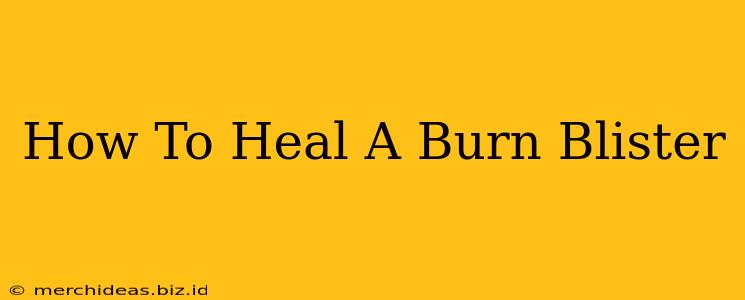Burns are a common household injury, and blisters often accompany them. While most minor burns heal on their own, understanding how to properly care for a burn blister is crucial to prevent infection and promote faster healing. This comprehensive guide will walk you through the best practices for healing a burn blister, from immediate first aid to long-term care.
Understanding Burn Blisters
A burn blister is a fluid-filled sac that forms on the skin in response to a burn. The blister's fluid is mostly plasma, which helps to cushion the underlying damaged skin and aid in the healing process. Resist the urge to pop it! Breaking the blister increases the risk of infection and could delay healing.
Types of Burns and Blister Formation
The severity of a burn influences the type and size of blister that forms. Minor burns, like those from a brief touch of a hot surface, often result in small, fluid-filled blisters. More serious burns may cause larger, more painful blisters, or even extensive skin damage without blister formation.
First Aid for Burn Blisters
Immediate first aid is critical in minimizing damage and promoting healing:
1. Cool the Burn:
Immediately run cool (not cold!) water over the burn for 10-20 minutes. This helps to reduce pain and inflammation. Avoid ice, as it can further damage the skin.
2. Remove Clothing:
Carefully remove any clothing or jewelry that is near the burn to prevent further irritation. If the clothing is stuck to the burn, do not force it off. Instead, seek medical attention.
3. Protect the Blister:
Gently cover the burn blister with a clean, non-stick bandage to protect it from further injury and infection. Avoid using cotton or fluffy materials that can stick to the blister.
Home Treatment for Healing Burn Blisters
Once the immediate first aid is complete, focus on these home treatments:
1. Keep it Clean:
Wash the area around the blister gently with mild soap and water once a day. Be careful not to scrub the blister itself.
2. Keep it Dry:
Allow the blister to air dry whenever possible. Change the bandage regularly to keep the area clean and dry.
3. Over-the-Counter Pain Relief:
Over-the-counter pain relievers like ibuprofen or acetaminophen can help manage pain and inflammation.
4. Aloe Vera:
Many find that applying aloe vera gel to the burn blister soothes the skin and promotes healing. Use pure aloe vera gel, not products containing added fragrances or chemicals.
5. Honey:
Honey has natural antibacterial properties and can help to prevent infection. Apply a thin layer of honey to the bandage before covering the blister.
When to Seek Medical Attention
While most minor burn blisters heal on their own, seek medical attention if:
- The burn is deep or large.
- The blister is extremely painful.
- The blister is infected (showing signs of redness, swelling, pus, or increased pain).
- You have a fever.
- The burn is on your face, hands, feet, genitals, or a major joint.
- You have diabetes or another condition that affects healing.
Preventing Burn Blisters
Prevention is always better than cure. Here are some tips to minimize your risk of burn blisters:
- Be cautious around heat sources: Use oven mitts, turn pot handles inward, and avoid touching hot surfaces.
- Use sunscreen: Sunburns are a common cause of blisters.
- Practice safe cooking habits: Be careful when using hot oil or other liquids.
- Wear protective clothing: When working with potentially hazardous materials or equipment.
By following these tips and seeking medical attention when necessary, you can effectively heal a burn blister and prevent further complications. Remember, patience and proper care are key to a quick and complete recovery.
